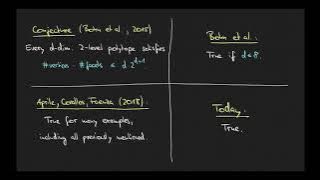8-polytopes | E8 (mathematics)
E8 polytope
In 8-dimensional geometry, there are 255 uniform polytopes with E8 symmetry. The three simplest forms are the 421, 241, and 142 polytopes, composed of 240, 2160 and 17280 vertices respectively. These polytopes can be visualized as symmetric orthographic projections in Coxeter planes of the E8 Coxeter group, and other subgroups. (Wikipedia).



















